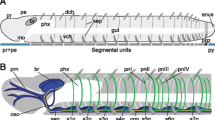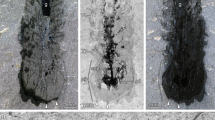Abstract
Nervous systems are important in assessing interphyletic phylogenies because they are conservative and complex. Regarding nervous system evolution within deuterostomes, two contrasting hypotheses are currently discussed. One that argues in favor of a concentrated, structured, central nervous system in the last common ancestor of deuterostomes (LCAD); the other reconstructing a decentralized nerve net as the nervous system of the LCAD. Here, we present a morphological analysis of the nervous system of the pterobranch deuterostome Cephalodiscus gracilis Harmer, 1905 based on transmission electron microscopy, confocal laser scanning microscopy, immunohistochemistry, and computer-assisted 3D reconstructions based on complete serial histological sections. The entire nervous system constitutes a basiepidermal plexus. The prominent dorsal brain at the base of the mesosomal tentacles contains an anterior concentration of serotonergic neurons and a posterior net of neurites. Predominant neurite directions differ between brain regions and synapses are present, indicating that the brain constitutes a centralized portion of the nervous system. Main structures of the peripheral nervous system are the paired branchial nerves, tentacle nerves, and the ventral stalk nerve. Serotonergic neurites are scattered throughout the epidermis and are present as concentrations along the anterior border of the branchial nerves. Serotonergic neurons line each tentacle and project into the brain. We argue that the presence of a centralized brain in C. gracilis supports the hypothesis that a nerve center was present in the LCAD. Moreover, based on positional and structural similarity, we suggest that the branchial nerves in C. gracilis could be homologous to branchial nerves in craniates, a hypothesis that should be further investigated.







Similar content being viewed by others
References
Akasaka K, Omori A, Amemiya S (2005) Primitive central nervous system of stalked crinoids (M rotundus). Zool Sci 22:1389
Arendt D, Nübler-Jung K (1999) Comparison of early nerve cord development in insects and vertebrates. Development 126:2309–2325
Arendt D, Denes AS, Jekely G, Tessmar-Raible K (2008) The evolution of nervous system centralization. Phil Trans R Soc B 363:1523–1528
Ax P (2001) Das System der Metazoa: ein Lehrbuch der phylogenetischen Systematik. Spektrum Akademischer Verlag GmbH, Heidelberg
Bateson W (1885) The later stages in the development of Balanoglossus kowalevskyi, with a suggestion on the affinities of the Enteropneusta. Q J Microsc Sci 25:81
Benito J, Pardos F (1997) Hemichordata. In: Harrison FW, Ruppert EE (eds) Microscopic anatomy of invertebrates, vol 15. Wiley, New York, Chichester, Weinheim, Brisbane, Singapore, Toronto, pp 15–101
Bolker JA, Raff RA (1996) Developmental genetics and traditional homolgy. Bioessays 18:489–494
Bone Q (1961) The Organization of the Atrial Nervous System of Amphioxus (Branchiostoma lanceolatum (Pallas)). Phil Trans R Soc Lond Ser B Biol Sci 243:241–269
Bullock TH (1944) The giant nerve fiber system in balanoglossids. J Comp Neurol 80:355–367
Burke RD (2011) Deuterostome neuroanatomy and the body plan paradox. Evol Dev 13:110–115
Candiani S, Augello A, Oliveri D, Passalacqua M, Pennati R, De Bernardi F, Pestarino M (2001) Immunocytochemical localization of serotonin in embryos, larvae and adults of the lancelet, Branchiostoma flordiae. Histochem J 33:413–420
De Bernardi F, Pennati R, Candiani S, Zega G, Groppelli S, Pestarino M (2006) Serotonin in the morphogenesis of ascidian nervous system. Caryologia 59:375–379
de Pinna MCC (1991) Concepts and tests of homology in the cladistic paradigm. Cladistics 7:367–394
Dickinson WJ (1995) Molecules and morphology: where’s the homology? Trends Genet 11:119–121
Dilly PN (1975) The pterobranch Rhabdopleura compacta: its nervous system and phylogenetic position. Symp Zool Soc Lond 36:1–16
Dilly PN, Welsch U, Storch V (1970) The Structure of the nerve fibre layer and neurocord in the enteropneusts. Zeitschrift für Zellforschung 103:129–148
Dunel-Erb S, Bailly P, Laurent S (1982) Neuroepithelial cells in fish gill primary lamellae. J Appl Physiol 53:1342–1353
Edgecombe G, Giribet G, Dunn C, Hejnol A, Kristensen R, Neves R, Rouse G, Worsaae K, Sørensen M (2011) Higher-level metazoan relationships: recent progress and remaining questions. Org Divers Evol 11:151–172
Ereshefsky M (2009) Homology: integrating phylogeny and development. Biol Theory 4:225–229
Harzsch S (2007) The architecture of the nervous system provides important characters for phylogenetic reconstructions: examples from the Arthropoda. Species Phylogeny Evol 1:33–57
Harzsch S, Müller C, Rieger V, Perez Y, Sintoni S, Sardet C, Hansson B (2009) Fine structure of the ventral nerve centre and interspecific identification of individual neurons in the enigmatic Chaetognatha. Zoomorphology 128:53–73
Hay-Schmidt A (2000) The evolution of the serotonergic nervous system. Phil Trans R Soc Lond B 267:1071–1079
Hejnol A, Obst M, Stamatakis A, Ott M, Rouse GW, Edgecombe GD, Martinez P, Baguna J, Bailly X, Jondelius U, Wiens M, Möller WEG, Seaver E, Wheeler WC, Martindale MQ, Giribet G, Dunn CW (2009) Assessing the root of bilaterian animals with scalable phylogenomic methods. Proc R Soc B: Biol Sci 276:4261–4270
Hennig W (1950) Grundzüge einer Theorie der phylogenetischen Systematik. Deutscher Zentralverlag, Berlin
Holland ND (2003) Early central nervous sytem evolution: an era of skin brains? Nature 4:1–11
Holland L (2009) Chordate roots of the vertebrate nervous system: expanding the molecular toolkit. Nat Rev Neurosci 10:736–746
Holland ND, Holland LZ (1993) Serotonin-containing cells in the nervous system and other tissues during ontogeny of a lancelet, Branchiostoma floridae. Acta Zoologica 74:195–204
Holland LZ, Holland ND, Gilland E (2008) Amphioxus and the evolution of head segmentation. Integr Comp Biol 48:630–646
Horie T, Shinki R, Ogura Y, Kusakabe TG, Satoh N, Sasakura Y (2011) Ependymal cells of chordate larvae are stem-like cells that form the adult nervous system. Nature 469:525–528
Imai JH, Meinertzhagen IA (2007) Neurons of the ascidian larval nervous system in Ciona intestinalis: I. Central nervous system. J Comparat Neurol 501:316–334
Jenner RA (2004) Towards a phylogeny of the Metazoa: evaluating alternative phylogenetic positions of Platyhelminthes, Nemertea, and Gnathostomulida, with a critical reappraisal of cladistic characters. Contrib Zool 73:3–163
Jonz MG, Zaccone G (2009) Nervous control of the gills. Acta Histochem 111:207–216
Kaul S, Stach T (2010) Ontogeny of the collar cord: neurulation in the hemichordate Saccolglossus kowalevskii. J Morphol 271:1240–1259
Knight-Jones EW (1952) On the nervous system of Saccoglossus cambrensis (Enteropneusta). Phil Trans R Soc Lond B 236:315–354
Kristensen RM (2002) An introduction to Loricifera, Cyliophora, and Micrognathozoa. Integr Comp Biol 42:641–651
Kugler J, Kerner P, Bouquet J-M, Jiang D, Di Gregorio A (2011) Evolutionary changes in the notochord genetic toolkit: a comparative analysis of notochord genes in the ascidian Ciona and the larvacean Oikopleura. BMC Evol Biol 11:21
Kuratani S (2008) Is the vertebrate head segmented?—evolutionary and developmental considerations. Integr Comp Biol 48:647–657
Kuratani S, Ueki T, Aizawa S, Hirano S (1997) Peripheral development of cranial nerves in a cyclostome, Lampetra japonica: morphological distribution of nerve branches and the vertebrate body plan. J Comp Neurol 384:483–500
Lacalli TC (2008) Basic features of the ancestral chordate brain: A protochordate perspective. Brain Res Bull 75:319–323
Lemaire P (2006) How many ways to make a chordate? Science 312:1145–1146
Lemaire P (2009) Unfolding a chordate developmental program, one cell at a time: invariant cell lineages, short-range inductions and evolutionary plasticity in ascidians. Dev Biol 332:48–60
Loesel R, Heuer CM (2010) The mushroom bodies—prominent brain centres of arthropods and annelids with enigmatic evolutionary origin. Acta Zoologica 91:29–34
Lowe CJ, Wu M, Salic A, Evans L, Lander E, Stange-Thomann N, Gruber CE, Gerhart J, Kirschner M (2003) Anteroposterior patterning in hemichordates and the origin of the chordate nervous system. Cell 113:853–865
Lowe CJ, Terasaki M, Wu M, Freeman RM Jr, Runft L, Kwan K, Haigo S, Aronowicz J, Lander E, Gruber C, Smith M, Kirschner M, Gerhart J (2006) Dorsoventral patterning in hemichordates: insights into early chordate evolution. PLoS Biol 4:e291
Meves A (1973) Elektronenmikroskopische Untersuchungen über die Zytoarchitektur des Gehirns von Branchiostoma lanceolatum. Zeitschrift für Zellforschung 139:511–532
Mickoleit G (2004) Phylogenetische Systematik der Wirbeltiere. Verlag Dr. Friedrich Pfeil, München
Nielsen C (1999) Origin of the chordate central nervous system—and the origin of the chordates. Dev Genes Evol 209:198–205
Nielsen C (2001) Animal evolution. Interrelationships of the living phyla. Oxford University Press, New York, Tokyo
Nielsen C, Hay-Schmidt A (2007) Development of the enteropneust Ptychodera flava: ciliary bands and nervous system. J Morphol 268:551–570
Nielsen C, Martinez P (2003) Patterns of gene expression: homology or homocracy? Dev Genes Evol 213:149–154
Nieuwenhuys R (2002) Deuterostome brains: synopsis and commentary. Brain Res Bull 57:257–270
Nomaksteinsky M, Roettinger E, Dufour HD, Chettouh Z, Lowe CJ, Martindale MQ, Brunet J-F (2009) Centralization of the deuterostome nervous system predates chordates. Curr Biol 19:1264–1269
Patterson C (1988) Homology in classical and molecular biology. Mol Biol Evol 5:603–625
Pflüger HJ, Stevenson PA (2005) Evolutionary aspects of octopaminergic systems with emphasis on arthropods. Arthropod Struct Dev 34:379–396
Rehkämper G, Welsch U, Dilly PN (1987) Fine structure of the ganglion of Cephalodiscus gracilis (Pterobranchia, Hemichordata). J Comp Neurol 259:308–315
Richter S (2005) Homologies in phylogenetic analyses—concept and tests. Theory Biosci 124:105–120
Richter S, Loesel R, Purschke G, Schmidt-Rhaesa A, Scholtz G, Stach T, Vogt L, Wanninger A, Brenneis G, Döring C, Faller S, Fritsch M, Grobe P, Heuer CM, Kaul S, Møller OS, Müller CHG, Rieger V, Rothe BH, Stegner MEJ, Harzsch S (2010) Invertebrate neurophylogeny: suggested terms and definitions for a neuroanatomical glossary. Front Zool 7:29
Satoh N (2008) An aboral-dorsalization hypothesis for chordate origin. Genesis 46:614–622
Schepotieff A (1907) Die Pterobranchier. Zoologische Jahrbücher Abteilung für Anatomie 23:463–534, Tafeln 425–433
Stach T (2000) Microscopic anatomy of developmental stages of Branchiostoma lanceolatum (Cephalochordata, Chordata). Bonn Zool Monogr 47:1–111
Stach T (2005) Comparison of the serotonergic nervous system among Tunicata: implications for its evolution within Chordata. Org Divers Evol 5:15–24
Swalla BJ (2006) Building divergent body plans with similar genetic pathways. Heredity 97:235–243
Swalla BJ, Smith AB (2008) Deciphering deuterostome phylogeny: molecular, morphological and palaeontological perspectives. Phil Trans R Soc Lond B 363:1557–1568
Tomer R, Denes AS, Tessmar-Raible K, Arendt D (2010) Profiling by image registration reveals common origin of annelid mushroom bodies and vertebrate pallium. Cell 142:800–809
Vogt L, Bartolomaeus T, Giribet G (2010) The linguistic problem of morphology: structure versus homology and the standardization of morphological data. Cladistics 26:301–325
Wanninger A, Fuchs J, Haszprunar G (2007) Anatomy of the serotonergic nervous system of an entoproct creeping-type larva and its phylogenetic implications. Invertebr Biol 126:268–278
Wicht H, Lacalli TC (2005) The nervous system of amphioxus: structure, development, and evolutionary significance. Can J Zool 83:122–150
Yasui K, Kaji T (2008) The lancelet and ammocoete Mouths. Zool Sci 25:1012–1019
Acknowledgments
We gratefully acknowledge the financial support of the German research foundation (DFG grants: Sta 655/2-1&2) and the financial support of the Biological Institute of Ocean Sciences (Grants-in-Aid Program). TS is grateful for the expert help of Carolin Beschow and Katrin Braun.
Author information
Authors and Affiliations
Corresponding author
Additional information
Communicated by T. Bartolomaeus.
Alexander Gruhl and Sabrina Kaul-Strehlow were contributed equally to this work.
Electronic supplementary material
Below is the link to the electronic supplementary material.
435_2011_144_MOESM1_ESM.eps
Additional file 1—Uncolored version of transmission electron micrograph depicted in Figure 4a. Supplementary material 1 (EPS 11825 kb)
435_2011_144_MOESM2_ESM.mpg
Additional file 2—3D animation movie of the nervous system of the pterobranch Cephalodiscus gracilis with outline of epidermis. Supplementary material 2 (MPG 5379 kb)
435_2011_144_MOESM3_ESM.mpg
Additional file 3—3D animation movie of the nervous system of the pterobranch Cephalodiscus gracilis at higher magnification. Supplementary material 3 (MPG 2050 kb)
Rights and permissions
About this article
Cite this article
Stach, T., Gruhl, A. & Kaul-Strehlow, S. The central and peripheral nervous system of Cephalodiscus gracilis (Pterobranchia, Deuterostomia). Zoomorphology 131, 11–24 (2012). https://doi.org/10.1007/s00435-011-0144-x
Received:
Revised:
Accepted:
Published:
Issue Date:
DOI: https://doi.org/10.1007/s00435-011-0144-x




